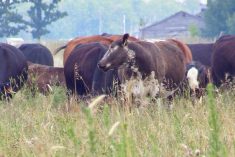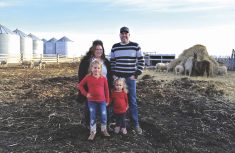Like a doctor delivering bad news to a patient, Martin Gooch gave it straight to the Ontario sheep sector: the sheep industry continues to be disjointed and inefficient, with a lack of benchmarks to define a successful farm.
Like a good doctor, Gooch also delivered some optimism.
“You could double production and have room for growth and that is without expanding the current market for lamb,” says Martin Gooch, chief executive officer of Value Chain Management International. His organization analysed the state of the industry for Ontario Sheep Farmers. Gooch says there’s more potential in lamb production than in any other sector of the Canadian agriculture sector. He presented the results of the analysis at the Ontario Sheep Convention in Alliston, Ont.
Ontario Sheep Farmers chair Rob Scott says the goal of the study was to identify barriers to expansion in the industry.

“I was adamant, because of feedback I got from producers, that this not be the type of benchmarking study that got put in a folder and put on a shelf. I’m very happy with the way it turned out.”
Ontario Sheep Farmers has adopted Gooch’s report and has started to work on its recommendations under the EweGROW program name, which General Manager Jennifer MacTavish says will be one of the organization’s flagship programs.
The information wasn’t new, as Ontario lamb production has suffered from great potential at the same time as a lack of sector-wide growth for generations, despite attempts at building value-chain models in the past.
Gooch identified several foundational steps that are lacking in the sector that competitors around the world implemented decades ago.
Read Also

The wildly adaptable side of next gen agriculture
Some people just fall into the world of agriculture — and consider themselves lucky to have stumbled into such a…
He says the sector has the characteristics of an emerging industry, with a lack of reliable information, marketing orientation and collective behaviour.
A lack of grading system and market communications means that lamb producers are not rewarded for producing higher quality lamb.
Gooch says the extensive surveys done with farmers and others in the sector during the study show that the lack of sector foundations has meant discouraged producers, especially larger sheep farmers with more than 400 ewes.
“Lamb is not rewarded according to its value,” says Gooch, meaning that a producer of high quality lamb versus low quality lamb isn’t rewarded enough for their work producing a better product.
Gooch’s report outlines first steps that can be taken to create more information flow, knowledge and eventually more sales in the industry. The roadmap aims for the industry to adopt the ethos of continuous improvement that underlies other sectors.
The first is benchmarking, which has been lacking in the industry. It’s one of the reasons why there is little understanding of what are the gold standards, the best ways to produce lamb and make business decisions in the Ontario market.
Gooch’s study looked at Ontario’s competitors including the UK, Australia and New Zealand. In Australia they have been benchmarking sheep flocks over 1000 ewes since the 1970s, in New Zealand, they have been gathering 1300 data points from 550 farm visits each year since the 1950s, and in the United Kingdom, average-sized flocks have been surveyed since 1936.
Meat quality is the second area where improvement is needed, says Gooch and that starts with actually measuring it.
“The purpose of grading is misunderstood,” says Gooch. “The grading purpose is to provide objective feedback to producers on the value of lamb and how their operations are performing.
It can help to create common language that applies from farm to farm. Grading rewards producers that create good value and penalizes those who don’t.
Gooch’s third area where the industry needs to improve is in research and engagement. The sheep industry has much lower levels of research conducted at the University of Guelph compared to other industry sectors, says Gooch.
Ontario Sheep Farmers has started collecting grading data and will continue to do so, involving processors, the Ontario Ministry of Agriculture Food and Rural Affairs as well as data from producers.
“Every year we’re going to get the processors to provide us with information on how lambs have been grading, to show the industry and the processors if there’s been any improvement,” says MacTavish.
The data will also help make the case for the sheep industry during discussions with funders and government.
“We have historically been short of the information needed to go in to make proper arguments,” says Scott. “Some of the stuff that’s going to come out of this is things we aren’t going to want to hear, but it’s what we have to hear.”
Through all the inability to fill the Ontario market, shepherds are still getting strong prices for lamb. That’s a disconnect from the global market where lamb is priced lower. That also means suppliers around the world are looking at the Canadian market.
An international marketing group set up a bridgehead in Toronto to figure out how they can get more of their lamb into the Ontario and Canadian market, says Gooch.
“Your market is so good, international competitors are purposely targeting your market,” he says. “You have other people stealing your breakfast.”
















